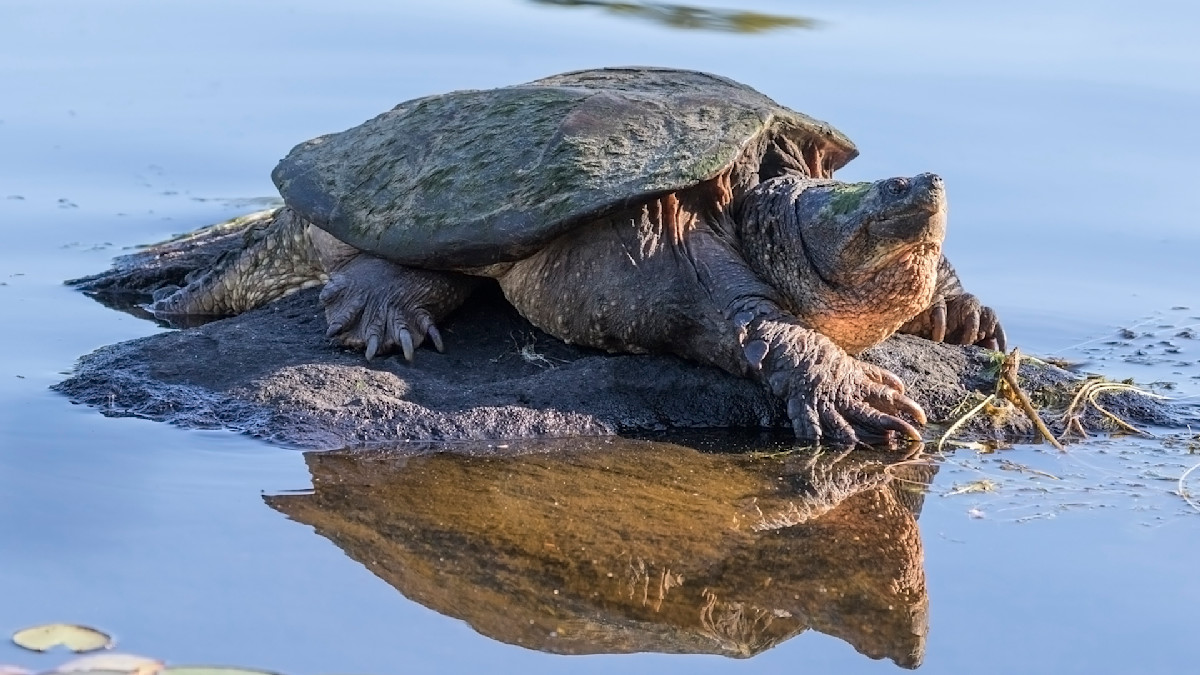To catch a snapping turtle in a pond, use a baited trap or lure it with food. Snapping turtles are commonly found in ponds and can be caught using these methods.
Snapping turtles are known for their aggressive behavior and sharp jaws, making it important to handle them carefully. Before attempting to catch a snapping turtle, ensure you have the necessary equipment, such as a sturdy trap or strong fishing line.
It is also recommended to wear protective gloves to prevent any injuries. By following these steps, you can safely and effectively catch a snapping turtle in a pond.
Understanding Snapping Turtles
Identifying A Snapping Turtle
A snapping turtle is easily identifiable by its large head, pointed beak, and a long tail with jagged edges. Their shell, or carapace, is dark brown or black and can reach up to 18 inches in length. Snapping turtles also have distinctive ridges on their shells and long, powerful legs with webbed feet.
Behavior And Habitat
Snapping turtles are primarily aquatic and can be found in freshwater habitats such as ponds, lakes, and slow-moving rivers. They prefer muddy bottoms and dense vegetation where they can hide and ambush their prey. These turtles are known for their aggressive behavior and powerful bite, making them formidable predators in their environment.
Preparing To Catch A Snapping Turtle
To catch a snapping turtle in a pond, first, gather the necessary equipment: a sturdy net, gloves, and a container. Approach the turtle slowly and carefully, using the net to capture it. Lift the turtle gently and place it in the container, ensuring it is secure before moving it to a safe location.
Gathering Necessary Equipment
Before attempting to catch a snapping turtle in a pond, you need to gather the right equipment.
- Fishing Net: A sturdy fishing net with a long handle is essential for safely capturing the turtle.
- Gloves: Thick, protective gloves will shield your hands from potential bites or scratches.
- Bucket or Container: Have a secure container ready to transport the turtle after capture.
Safety Precautions
When it comes to catching snapping turtles, safety should be your top priority.
- Approach Cautiously: Always approach the turtle slowly and from the back to avoid startling it.
- Keep Distance: Maintain a safe distance and never attempt to grab the turtle with your hands.
- Use Proper Handling Techniques: Lift the turtle gently and support its body to prevent injury.
- Release Carefully: When releasing the turtle back into the pond, ensure a smooth and safe return.
Techniques For Catching A Snapping Turtle
Snapping turtles are fascinating creatures that can be found in ponds and water bodies. If you’re interested in catching a snapping turtle, it’s important to understand the techniques for spotting, approaching, and handling these creatures safely and responsibly. Below, we’ll discuss the key methods for catching a snapping turtle in a pond.
Spotting A Snapping Turtle
When attempting to catch a snapping turtle, it’s essential to first identify its presence in the pond. Look for signs such as the turtle’s head peeking above the water’s surface or its distinctive shell. Additionally, keep an eye out for ripples or movements in the water, which could indicate the turtle’s location.
Approaching And Handling
Approaching a snapping turtle requires caution and patience. Carefully move towards the turtle, avoiding sudden movements that could startle it. Once within reach, it’s crucial to handle the turtle with gentleness and precision. Use a sturdy tool, such as a net or a turtle hook, to lift the turtle out of the water. Keep a safe distance from its powerful jaws and handle it with care to prevent injury to both yourself and the turtle.

Credit: www.themeateater.com
Removing The Snapping Turtle From The Pond
Catching a snapping turtle in a pond can be a challenging task. Once you have successfully caught the turtle, the next step is to remove it from the pond. In this article, we will discuss two methods for removing a snapping turtle from a pond: using a turtle trap and manual capture.
Using A Turtle Trap
One of the easiest and most effective ways to remove a snapping turtle from a pond is by using a turtle trap. Turtle traps are designed to lure in turtles with bait and trap them inside. Follow these steps to use a turtle trap:
- Choose the right trap size: Make sure the trap is large enough to accommodate the size of the turtle you are trying to catch.
- Bait the trap: Place bait, such as fish or chicken, in the trap.
- Place the trap in the water: Position the trap in the water where you have spotted the turtle.
- Check the trap regularly: Check the trap at least once a day. Once you have caught the turtle, remove it from the trap and transport it to a new location.
Manual Capture
If you do not have access to a turtle trap, you can try to manually capture the snapping turtle. However, this method can be dangerous and should only be attempted by experienced individuals. Follow these steps to manually capture a snapping turtle:
- Wear protective gear: Before attempting to capture the turtle, make sure you are wearing protective gear, such as gloves and long sleeves.
- Approach the turtle from behind: Snapping turtles have a limited range of motion behind their shell, so approaching from behind is safer than approaching from the front.
- Grab the turtle by the shell: Use both hands to grab the turtle by the shell, making sure to keep your fingers away from its head and tail.
- Lift the turtle out of the water: Once you have a good grip on the turtle, lift it out of the water and transport it to a new location.
Remember, snapping turtles can be dangerous and should be handled with care. Always release the turtle in a safe location away from people and other animals.
Handling And Transporting The Turtle
To catch a snapping turtle in a pond, approach slowly from behind to avoid startling it. Use a net or trap to safely handle and transport the turtle without causing harm. Remember to release it back into the water in a suitable habitat after catching it.
If you have successfully caught a snapping turtle, the next step is to handle and transport it safely. It is important to take proper precautions to prevent any harm to the turtle and yourself. Here are some proper handling procedures and transporting techniques to ensure the safety of both you and the turtle.Proper Handling Procedures
When handling a snapping turtle, it is crucial to take precautions to avoid injury from the turtle’s sharp beak and claws. Follow these steps for safe handling:- Wear thick gloves to protect your hands and fingers from bites and scratches.
- Hold the turtle by the rear of the shell, keeping your fingers away from the head and tail.
- Avoid lifting the turtle too high as it may cause the turtle to feel threatened and become aggressive.
- If the turtle starts to hiss, it is a sign of aggression. Lower the turtle back into the water and try again later.
- Do not handle the turtle for too long, as it may become stressed or exhausted.
Transporting To A New Location
If you are relocating the turtle to a new location, it is important to transport it safely and humanely. Here are some tips for transporting a snapping turtle:- Use a sturdy container with a lid to transport the turtle. The container should be large enough for the turtle to move around comfortably but not too large that it can move around too much.
- Place a damp towel or newspaper at the bottom of the container to keep the turtle moist and prevent it from sliding around during transportation.
- Do not transport the turtle in a vehicle with extreme temperatures, as it may cause stress or harm to the turtle.
- Release the turtle in a suitable habitat, such as a pond or lake, away from any busy roads or areas of human activity.
- Never release a snapping turtle into a habitat where it is not native, as it may cause harm to the local ecosystem.

Credit: www.youtube.com
Releasing The Turtle Safely
Catching a snapping turtle in a pond can be quite an adventure, but releasing it safely back into its natural habitat is equally important. Knowing the right techniques for releasing the turtle ensures its well-being and the safety of the environment.
Choosing A Suitable Release Site
When releasing a snapping turtle back into the wild, it’s crucial to select a suitable release site. The chosen location should be close to where the turtle was initially found and provide similar habitat conditions. Look for a calm, shallow area with ample vegetation and adequate food sources. Avoid releasing the turtle near areas with heavy human activity or potential predators.
Releasing The Turtle
When releasing the turtle, it’s important to handle it with care to prevent any stress or injury. Gently place the turtle on the ground near the water’s edge and allow it to move towards the pond at its own pace. Avoid dropping the turtle into the water from a height, as this could cause harm. Observe from a distance to ensure the turtle safely enters the water and swims away.
Safety And Legal Considerations
To safely catch a snapping turtle in a pond, ensure you have the necessary permits and follow local regulations. Use a sturdy net or trap to capture the turtle gently and release it back into the pond unharmed. Always prioritize the safety of both yourself and the turtle during the process.
Safety Guidelines – Always wear protective gloves when handling snapping turtles. – Approach slowly and avoid sudden movements to prevent startling the turtle. – Use a sturdy tool like a long-handled net to safely capture the turtle. – Avoid touching the turtle directly as they have powerful jaws and sharp claws. – Do not attempt to pick up a snapping turtle by its tail. – Release the turtle back into the pond gently and from a safe distance. Legal Regulations – Check local laws and regulations regarding the capture of snapping turtles. – Inquire about any permits required for capturing and handling wildlife. – Follow ethical guidelines for interacting with wildlife in their natural habitat. – Ensure you are not violating any laws by capturing snapping turtles from the pond. – Respect wildlife conservation efforts and protect the natural ecosystem.Conservation And Ethical Practices
Conservation and ethical practices are vital when engaging in wildlife activities, including catching snapping turtles in a pond. By understanding and adhering to conservation efforts and ethical treatment of wildlife, individuals can ensure the safety and well-being of the snapping turtle population while also respecting their natural habitat.
Conservation Efforts
Conservation efforts play a crucial role in protecting snapping turtles and their natural habitats. It is essential to be mindful of local regulations and guidelines regarding the capture and handling of snapping turtles. Additionally, efforts should be made to minimize disturbances to the pond ecosystem while pursuing the capture of snapping turtles.
Ethical Treatment Of Wildlife
When catching snapping turtles, it is imperative to prioritize their well-being and minimize stress. Using appropriate and non-harmful capture methods, such as turtle traps or gentle hand capture, can help ensure the ethical treatment of these creatures. Once captured, handling should be done with care and respect for the turtle’s natural behaviors and needs.

Credit: www.themeateater.com
Conclusion
After learning the methods to catch a snapping turtle in a pond, you are now equipped with the knowledge and skills needed. Remember to approach with caution and patience. By following the tips provided, you can safely and effectively capture a snapping turtle in its natural habitat.
Happy snapping!





Leave a Reply